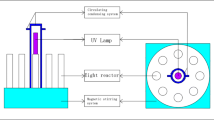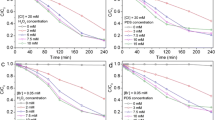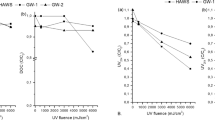Abstract
UV/peroxymonosulfate (UV/PMS) is a promising advanced oxidation technology in water treatment. This study aimed to investigate the impact of UV/PMS on humic acid (HA) and the influence of PMS dosage, pretreatment time, pH pretreatment, nitrate, nitrite, ammonium, and bicarbonate influencing factors on disinfection byproduct (DBP) formation during post-chlorination. With increased PMS dosage or pretreatment time, the UV/PMS treatment significantly reduced ultraviolet absorbance and increased mineralization. It altered the fractional constituent as humic substances were gradually transformed into building blocks and low-molecular-weight acids. However, most DBP formation increased initially and then decreased after subsequent chlorination. Rising nitrate or nitrite concentrations markedly promoted halonitromethane (HNM) formation. The presence of ammonia had a more significant impact on dichloroacetonitrile (DCAN) formation. Bicarbonate in UV/PMS pretreatment increased carbonated disinfection byproduct (C-DBP) formation, whereas it had a negligible impact on nitrogenous disinfection byproduct (N-DBP) formation. The present study revealed the impact of a series of influencing factors on DBP formation in UV/PMS reaction systems, providing comprehensive insights on applying UV/PMS in actual practice.





Similar content being viewed by others
Data availability
Some of data and materials used during this study are available from the corresponding author by request.
References
Alayande AB, Hong S (2022) Ultraviolet light-activated peroxymonosulfate (UV/PMS) system for humic acid mineralization: effects of ionic matrix and feasible application in seawater reverse osmosis desalination. Environ Pollut 307:119513. https://doi.org/10.1016/j.envpol.2022.119513
Barzegar G, Sabaghan M, Azadbakht O, Aghayani E, Mahdavianpour M, Kadier A, Fallahizadeh S, Ghanbari F (2023) Ciprofloxacin degradation by catalytic activation of monopersulfate using Mn-Fe oxides: performance and mineralization. Water Sci Technol 87:1029–1042. https://doi.org/10.2166/wst.2023.059
Bond T, Templeton MR, Graham N (2012) Precursors of nitrogenous disinfection by-products in drinking water--a critical review and analysis. J Hazard Mater 235-236:1–16. https://doi.org/10.1016/j.jhazmat.2012.07.017
Brienza M, Manasfi R, Chiron S (2019) Relevance of N-nitrosation reactions for secondary amines in nitrate-rich wastewater under UV-C treatment. Water Res 162:22–29. https://doi.org/10.1016/j.watres.2019.06.055
Bu L, Sun J, Wu Y, Zhang W, Duan X, Zhou S, Dionysiou DD, Crittenden JC (2020) Non-negligible risk of chloropicrin formation during chlorination with the UV/persulfate pretreatment process in the presence of low concentrations of nitrite. Water Res 168:115194. https://doi.org/10.1016/j.watres.2019.115194
Chen B, Westerhoff P (2010) Predicting disinfection by-product formation potential in water. Water Res 44:3755–3762. https://doi.org/10.1016/j.watres.2010.04.009
Chu W, Chu T, Bond T, Du E, Guo Y, Gao N (2016) Impact of persulfate and ultraviolet light activated persulfate pre-oxidation on the formation of trihalomethanes, haloacetonitriles and halonitromethanes from the chlor(am)ination of three antibiotic chloramphenicols. Water Res 93:48–55. https://doi.org/10.1016/j.watres.2016.02.013
Chu W, Gao N, Yin D, Krasner SW, Mitch WA (2014) Impact of UV/H2O2 pre-oxidation on the formation of haloacetamides and other nitrogenous disinfection byproducts during chlorination. Environ Sci Technol 48:12190–12198. https://doi.org/10.1021/es502115x
Chu W, Li D, Gao N, Templeton MR, Tan C, Gao Y (2015) The control of emerging haloacetamide DBP precursors with UV/persulfate treatment. Water Res 72:340–348. https://doi.org/10.1016/j.watres.2014.09.019
Cortes C, Marcos R (2018) Genotoxicity of disinfection byproducts and disinfected waters: a review of recent literature. Mutat Res Genet Toxicol Environ Mutagen 831:1–12. https://doi.org/10.1016/j.mrgentox.2018.04.005
Debordea M, Uv G (2008) Reactions of chlorine with inorganic and organic compounds during water treatment-kinetics and mechanisms: a critical review. Water Res 42:13–51. https://doi.org/10.1016/j.watres.2007.07.025
Ding S, Chu W (2017) Recent advances in the analysis of nitrogenous disinfection by-products. Trends Environ Anal Chem 14:19–27. https://doi.org/10.1016/j.teac.2017.04.001
Dotson AD, Keen VOS, Metz D, Linden KG (2010) UV/H2O2 treatment of drinking water increases post-chlorination DBP formation. Water Res 44:3703–3713. https://doi.org/10.1016/j.watres.2010.04.006
Duan J, Cao X, Chen C, Shi D, Li G, Mulcahy D (2012) Effects of Ca(OH)2 assisted aluminum sulfate coagulation on the removal of humic acid and the formation potentials of tri-halomethanes and haloacetic acids in chlorination. J Environ Sci (China) 24:1609–1615. https://doi.org/10.1016/s1001-0742(11)60953-4
Gao ZC, Lin YL, Xu B, Xia Y, Hu CY, Zhang TY, Cao TC, Chu WH, Gao NY (2019) Effect of UV wavelength on humic acid degradation and disinfection by-product formation during the UV/chlorine process. Water Res 154:199–209. https://doi.org/10.1016/j.watres.2019.02.004
Ghanbari F, Moradi M (2017) Application of peroxymonosulfate and its activation methods for degradation of environmental organic pollutants: review. Chem Eng J 310:41–62. https://doi.org/10.1016/j.cej.2016.10.064
Ghanbari F, Wang Q, Hassani A, Waclawek S, Rodriguez-Chueca J, Lin KA (2021) Electrochemical activation of peroxides for treatment of contaminated water with landfill leachate: efficacy, toxicity and biodegradability evaluation. Chemosphere 279:130610. https://doi.org/10.1016/j.chemosphere.2021.130610
Goldstein S, Rabani J (2007) Mechanism of nitrite formation by nitrate photolysis in aqueous solutions: the role of peroxynitrite, nitrogen dioxide, and hydroxyl radical. J Am Chem Soc 129:10597–10601. https://doi.org/10.1021/ja073609+
Guo Z-B, Lin Y-L, Xu B, Hu C-Y, Huang H, Zhang T-Y, Chu W-H, Gao N-Y (2016) Factors affecting THM, HAN and HNM formation during UV-chlor(am)ination of drinking water. Chem Eng J 306:1180–1188. https://doi.org/10.1016/j.cej.2016.08.051
Hassani A, Eghbali P, Mahdipour F, Wacławek S, Lin K-YA, Ghanbari F (2023a) Insights into the synergistic role of photocatalytic activation of peroxymonosulfate by UVA-LED irradiation over CoFe2O4-rGO nanocomposite towards effective bisphenol A degradation: performance, mineralization, and activation mechanism. Chem Eng J 453:139556. https://doi.org/10.1016/j.cej.2022.139556
Hassani A, Scaria J, Ghanbari F, Nidheesh PV (2023b) Sulfate radicals-based advanced oxidation processes for the degradation of pharmaceuticals and personal care products: a review on relevant activation mechanisms, performance, and perspectives. Environ Res 217:114789. https://doi.org/10.1016/j.envres.2022.114789
Held AM, Halko DJ, Hurst JK (1978) Mechanisms of chlorine oxidation of hydrogen peroxide. J Am Chem Soc 100:5732–5740. https://doi.org/10.1021/ja00486a025
Hua G, Reckhow DA, Abusallout I (2015) Correlation between SUVA and DBP formation during chlorination and chloramination of NOM fractions from different sources. Chemosphere 130:82–89. https://doi.org/10.1016/j.chemosphere.2015.03.039
Hua Z, Kong X, Hou S, Zou S, Xu X, Huang H, Fang J (2019) DBP alteration from NOM and model compounds after UV/persulfate treatment with post chlorination. Water Res 158:237–245. https://doi.org/10.1016/j.watres.2019.04.030
Huang H, Chen B-Y, Zhu Z-R (2017) Formation and speciation of haloacetamides and haloacetonitriles for chlorination, chloramination, and chlorination followed by chloramination. Chemosphere 166:126–134. https://doi.org/10.1016/j.chemosphere.2016.09.047
Ike IA, Lee Y, Hur J (2019) Impacts of advanced oxidation processes on disinfection byproducts from dissolved organic matter upon post-chlor(am)ination: a critical review. Chem Eng J 375:121929. https://doi.org/10.1016/j.cej.2019.121929
Ike IA, Orbell JD, Duke M (2018) Activation of persulfate at waste heat temperatures for humic acid degradation. ACS Sustainable Chem Eng 6:4345–4353. https://doi.org/10.1021/acssuschemeng.7b04840
Jing K, Kong D, Lu J (2020) Change of disinfection byproducts formation potential of natural organic matter after exposure to persulphate and bicarbonate. Water Res 182:115970. https://doi.org/10.1016/j.watres.2020.115970
Kanjal MI, Muneer M, Abdelhaleem A, Chu W (2020) Degradation of methotrexate by UV/peroxymonosulfate: kinetics, effect of operational parameters and mechanism. Chin J Chem Eng 28:2658–2667. https://doi.org/10.1016/j.cjche.2020.05.033
Li K, Huang T, Qu F, Du X, Ding A, Li G, Liang H (2016) Performance of adsorption pretreatment in mitigating humic acid fouling of ultrafiltration membrane under environmentally relevant ionic conditions. Desalination 377:91–98. https://doi.org/10.1016/j.desal.2015.09.016
Li XF, Mitch WA (2018) Drinking water disinfection byproducts (DBPs) and human health effects: Multidisciplinary challenges and opportunities. Environ Sci Technol 52:1681–1689. https://doi.org/10.1021/acs.est.7b05440
Liu W, Zhang Z, Yang X, Xu Y, Liang Y (2012) Effects of UV irradiation and UV/chlorine co-exposure on natural organic matter in water. Sci Total Environ 414:576–584. https://doi.org/10.1016/j.scitotenv.2011.11.031
Liu X, Park M, Beitel SC, Hoppe-Jones C, Meng XZ, Snyder SA (2021) Formation of nitrogenous disinfection byproducts in MP UV-based water treatments of natural organic matters: The role of nitrate. Water Res 204:117583. https://doi.org/10.1016/j.watres.2021.117583
Liu Z, Xu B, Lin YL, Zhang TY, Ye T, Hu CY, Lu YS, Cao TC, Tang YL, Gao NY (2020) Mechanistic study on chlorine/nitrogen transformation and disinfection by-product generation in a UV-activated mixed chlorine/chloramines system. Water Res 184:116116. https://doi.org/10.1016/j.watres.2020.116116
Lou X, Xiao D, Fang C, Wang Z, Liu J, Guo Y, Lu S (2016) Comparison of UV/hydrogen peroxide and UV/peroxydisulfate processes for the degradation of humic acid in the presence of halide ions. Environ Sci Pollut Res Int 23:4778–4785. https://doi.org/10.1007/s11356-015-5232-x
Luo Y, Su R, Yao H, Zhang A, Xiang S, Huang L (2021) Degradation of trimethoprim by sulfate radical-based advanced oxidation processes: kinetics, mechanisms, and effects of natural water matrices. Environ Sci Pollut Res Int 28:62572–62582. https://doi.org/10.1007/s11356-021-15146-0
Lyon BA, Cory RM, Weinberg HS (2014) Changes in dissolved organic matter fluorescence and disinfection byproduct formation from UV and subsequent chlorination/chloramination. J Hazard Mater 264:411–419. https://doi.org/10.1016/j.jhazmat.2013.10.065
Lyon BA, Dotson AD, Linden KG, Weinberg HS (2012) The effect of inorganic precursors on disinfection byproduct formation during UV-chlorine/chloramine drinking water treatment. Water Res 46:4653–4664. https://doi.org/10.1016/j.watres.2012.06.011
Mack J, Bolton JR (1999) Photochemistry of nitrite and nitrate in aqueous solution a review. J Photochem Photobiol A 128:1–13. https://doi.org/10.1016/s1010-6030(99)00155-0
Metz DH, Meyer M, Dotson A, Beerendonk E, Dionysiou DD (2011) The effect of UV/H2O2 treatment on disinfection by-product formation potential under simulated distribution system conditions. Water Res 45:3969–3980. https://doi.org/10.1016/j.watres.2011.05.001
Oh W-D, Dong Z, Lim T-T (2016) Generation of sulfate radical through heterogeneous catalysis for organic contaminants removal: current development, challenges and prospects. Appl Catal B 194:169–201. https://doi.org/10.1016/j.apcatb.2016.04.003
Plewa MJ, Wagner ED, Muellner MG, Hsu KM, Richardson SD (2008) Comparative mammalian cell toxicity of N-DBPs and C-DBPs. ACS Symposium Series 995:36–50. https://doi.org/10.1021/bk-2008-0995.ch003
Qian Y, Hu Y, Chen Y, An D, Westerhoff P, Hanigan D, Chu W (2020) Haloacetonitriles and haloacetamides precursors in filter backwash and sedimentation sludge water during drinking water treatment. Water Res 186:116346. https://doi.org/10.1016/j.watres.2020.116346
Rayaroth MP, Aravindakumar CT, Shah NS, Boczkaj G (2022) Advanced oxidation processes (AOPs) based wastewater treatment - unexpected nitration side reactions - a serious environmental issue: a review. Chem Eng J 430:133002. https://doi.org/10.1016/j.cej.2021.133002
Richardson SD, Plewa MJ, Wagner ED, Schoeny R, Demarini DM (2007) Occurrence, genotoxicity, and carcinogenicity of regulated and emerging disinfection by-products in drinking water: a review and roadmap for research. Mutat Res 636:178–242. https://doi.org/10.1016/j.mrrev.2007.09.001
Shad A, Chen J, Qu R, Dar AA, Bin-Jumah M, Allam AA, Wang Z (2020) Degradation of sulfadimethoxine in phosphate buffer solution by UV alone, UV/PMS and UV/H2O2: kinetics, degradation products, and reaction pathways. Chem Eng J 398:125357. https://doi.org/10.1016/j.cej.2020.125357
Shah AD, Dotson AD, Linden KG, Mitch WA (2011) Impact of UV disinfection combined with chlorination/chloramination on the formation of halonitromethanes and haloacetonitriles in drinking water. Environ Sci Technol 45:3657–3664. https://doi.org/10.1021/es104240v
Shah AD, Mitch WA (2012) Halonitroalkanes, halonitriles, haloamides, and N-nitrosamines: a critical review of nitrogenous disinfection byproduct formation pathways. Environ Sci Technol 46:119–131. https://doi.org/10.1021/es203312s
Sillanpaa M, Ncibi MC, Matilainen A (2018) Advanced oxidation processes for the removal of natural organic matter from drinking water sources: a comprehensive review. J Environ Manage 208:56–76. https://doi.org/10.1016/j.jenvman.2017.12.009
Srivastav AL, Patel N, Chaudhary VK (2020) Disinfection by-products in drinking water: occurrence, toxicity and abatement. Environ Pollut 267:115474. https://doi.org/10.1016/j.envpol.2020.115474
Su R, Chai L, Tang C, Li B, Yang Z (2018) Comparison of the degradation of molecular and ionic ibuprofen in a UV/H2O2 system. Water Sci Technol 77:2174–2183. https://doi.org/10.2166/wst.2018.129
Tang S, Tang J, Yuan D, Wang Z, Zhang Y, Rao Y (2020) Elimination of humic acid in water: comparison of UV/PDS and UV/PMS. RSC Adv 10:17627–17634. https://doi.org/10.1039/d0ra01787f
Vughs D, Baken KA, Kolkman A, Martijn AJ, de Voogt P (2018) Application of effect-directed analysis to identify mutagenic nitrogenous disinfection by-products of advanced oxidation drinking water treatment. Environ Sci Pollut Res Int 25:3951–3964. https://doi.org/10.1007/s11356-016-7252-6
Wagner ED, Plewa MJ (2017) CHO cell cytotoxicity and genotoxicity analyses of disinfection by-products: an updated review. J Environ Sci (China) 58:64–76. https://doi.org/10.1016/j.jes.2017.04.021
Wang H, Zhu Y, Hu C, Hu X (2015) Treatment of NOM fractions of reservoir sediments: effect of UV and chlorination on formation of DBPs. Sep Purif Technol 154:228–235. https://doi.org/10.1016/j.seppur.2015.09.031
Wang J, Wang S (2018) Activation of persulfate (PS) and peroxymonosulfate (PMS) and application for the degradation of emerging contaminants. Chem Eng J 334:1502–1517. https://doi.org/10.1016/j.cej.2017.11.059
Wang W, Wang W, Fan Q, Wang Y, Qiao Z, Wang X (2014) Effects of UV radiation on humic acid coagulation characteristics in drinking water treatment processes. Chem Eng J 256:137–143. https://doi.org/10.1016/j.cej.2014.06.113
Wang WL, Zhang X, Wu QY, Du Y, Hu HY (2017) Degradation of natural organic matter by UV/chlorine oxidation: molecular decomposition, formation of oxidation byproducts and cytotoxicity. Water Res 124:251–258. https://doi.org/10.1016/j.watres.2017.07.029
Wu Y, Bu L, Duan X, Zhu S, Kong M, Zhu N, Zhou S (2020) Mini review on the roles of nitrate/nitrite in advanced oxidation processes: radicals transformation and products formation. J Clean Prod 273:123065. https://doi.org/10.1016/j.jclepro.2020.123065
Xie P, Ma J, Liu W, Zou J, Yue S (2015) Impact of UV/persulfate pretreatment on the formation of disinfection byproducts during subsequent chlorination of natural organic matter. Chem Eng J 269:203–211. https://doi.org/10.1016/j.cej.2015.01.043
Xu M, Deng J, Cai A, Ye C, Ma X, Li Q, Zhou S, Li X (2021a) Synergistic effects of UVC and oxidants (PS vs. Chlorine) on carbamazepine attenuation: mechanism, pathways, DBPs yield and toxicity assessment. Chem Eng J 413:127533. https://doi.org/10.1016/j.cej.2020.127533
Xu X, Kang J, Shen J, Zhao S, Wang B, Zhang X, Chen Z (2021b) EEM-PARAFAC characterization of dissolved organic matter and its relationship with disinfection by-products formation potential in drinking water sources of northeastern China. Sci Total Environ 774:145297. https://doi.org/10.1016/j.scitotenv.2021.145297
Yaghoot-Nezhad A, Waclawek S, Madihi-Bidgoli S, Hassani A, Lin KA, Ghanbari F (2023) Heterogeneous photocatalytic activation of electrogenerated chlorine for the production of reactive oxygen and chlorine species: a new approach for Bisphenol A degradation in saline wastewater. J Hazard Mater 445:130626. https://doi.org/10.1016/j.jhazmat.2022.130626
Yang P, Ji Y, Lu J (2021) Transformation of ammonium to nitrophenolic byproducts by sulfate radical oxidation. Water Res 202:117432. https://doi.org/10.1016/j.watres.2021.117432
Ye Z, Liu W, Sun W, Nie X, Ao X (2018) Role of ammonia on haloacetonitriles and halonitromethanes formation. Chem Eng J 337:275–281. https://doi.org/10.1016/j.cej.2017.12.073
Zhang A, Chen W, Gu Z, Li Q, Shi G (2018) Mechanism of adsorption of humic acid by modified aged refuse. RSC Adv 8:33642–33651. https://doi.org/10.1039/c8ra05933k
Zhang R, Wang F, Fang C, Luan X, Yang X, Chu W (2020a) Occurrence of CX3R-Type disinfection byproducts in drinking water treatment plants using DON-Rich source water. ACS ES & T Water 1:553–561. https://doi.org/10.1021/acsestwater.0c00051
Zhang S, Lin T, Chen H, Xu H, Chen W, Tao H (2020b) Precursors of typical nitrogenous disinfection byproducts: characteristics, removal, and toxicity formation potential. Sci Total Environ 742:140566. https://doi.org/10.1016/j.scitotenv.2020.140566
Zhang TY, Lu YS, Luo ZN, Sun WJ, Xu B, Hu CY, Tang YL, Dong ZY, Ren XM (2022) Micropollutant removal and disinfection byproduct control by sequential peroxymonosulfate-UV treatment in water: a case study with sulfamethoxazole. J Environ Sci (China) 117:141–157. https://doi.org/10.1016/j.jes.2022.03.046
Funding
This study was supported by Key Research and Development plan of Shandong Province (2020CXGC011406) and Natural Science Foundation of Shandong Province (ZR2021ME166).
Author information
Authors and Affiliations
Contributions
Lulu Dong: experiment, methodology, data analysis, writing—original draft and editing; Zhenxing Yao: methodology, supervision, writing—reviewing and editing; Shaohua Sun: writing—reviewing and editing; Mingquan Wang: writing—reviewing and editing; Ruibao Jia: writing—reviewing and editing, funding acquisition, project administration. All authors commented on previous versions of the manuscript. All authors read and approved the final manuscript.
Corresponding author
Ethics declarations
Ethics approval
Not application.
Consent to participate
Not application.
Consent for publication
Not application.
Competing interests
The authors declare no competing interests.
Additional information
Responsible Editor: Ricardo A. Torres-Palma
Publisher’s Note
Springer Nature remains neutral with regard to jurisdictional claims in published maps and institutional affiliations.
Supplementary information
ESM 1
(DOCX 462 kb)
Rights and permissions
Springer Nature or its licensor (e.g. a society or other partner) holds exclusive rights to this article under a publishing agreement with the author(s) or other rightsholder(s); author self-archiving of the accepted manuscript version of this article is solely governed by the terms of such publishing agreement and applicable law.
About this article
Cite this article
Dong, L., Yao, Z., Sun, S. et al. Effect of UV/peroxymonosulfate pretreatment on disinfection byproduct (DBP) formation during post-chlorination of humic acid. Environ Sci Pollut Res 31, 422–432 (2024). https://doi.org/10.1007/s11356-023-30908-8
Received:
Accepted:
Published:
Issue Date:
DOI: https://doi.org/10.1007/s11356-023-30908-8




